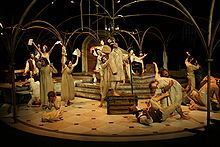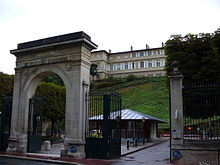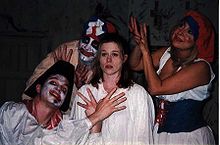- Marat/Sade
-
This article is about Peter Weiss' play. For Peter Brook and Adrian Mitchell's film based on the play, see Marat/Sade (film).
Marat/Sade 
Written by Peter Weiss Characters Marquis de Sade
Abbé de Coulmier
Jean-Paul Marat
Simonne Evrard
Charlotte Corday
Duperret
Jacques Roux
The Herald
Kokol
Polpoch
Cucurucu
RossignolMute Mme Coulmier
Mlle Coulmier
Male Nurses
Asylum inmates
Sisters
MusiciansDate premiered April 29, 1964 Place premiered Schillertheater, West Berlin, Germany Original language German Subject French Revolution, sado-masochism Genre A play with music Setting Charenton Asylum, France
1808IBDB profile The Persecution and Assassination of Jean-Paul Marat as Performed by the Inmates of the Asylum of Charenton Under the Direction of the Marquis de Sade (German: Die Verfolgung und Ermordung Jean Paul Marats dargestellt durch die Schauspielgruppe des Hospizes zu Charenton unter Anleitung des Herrn de Sade), almost invariably shortened to Marat/Sade, is a 1963 play by Peter Weiss. The work was first published in German.
Incorporating dramatic elements characteristic of both Artaud and Bertolt Brecht, it is a bloody and unrelenting depiction of class struggle and human suffering which asks whether true revolution comes from changing society or changing oneself.
Contents
Plot
Set in the historical Charenton Asylum, now l'Hôpital Esquirol, Marat/Sade is almost entirely a "play within a play". The main story takes place on July 13, 1808, after the French Revolution; the play directed by de Sade within the story takes place during the Revolution, in the middle of 1793, culminating in the assassination of Jean-Paul Marat (which took place on July 13, 1793), then quickly brings the audience up to date (1808). The actors are the inmates of the asylum, and the nurses and supervisors occasionally step in to restore order. The bourgeois director of the hospital, Coulmier, supervises the performance, accompanied by his wife and daughter. He is a supporter of the post-revolutionary government led by Napoleon, in place at the time of the production, and believes the play he has organised to be an endorsement of his patriotic views. His patients, however, have other ideas, and they make a habit of speaking lines he had attempted to suppress, or deviating entirely into personal opinion. Suffice it to say that they, as people who came out of the revolution no better than they went in, are not entirely pleased with the course of events as they fell.
The infamous Marquis de Sade, the man after whom sadism is named, did indeed direct performances in Charenton with other inmates there, encouraged by Coulmier. De Sade is a main character in the play, conducting many philosophical dialogues with Marat and observing the proceedings with sardonic amusement. He remains detached and cares little for practical politics and the inmates' talk of right and justice; he simply stands by as an observer and an advocate of his own nihilistic and individualist beliefs. One of the most powerful scenes of the play depicts him being whipped on his own instructions, and such bold scenes are not alone, nor confined to the predilections of the Marquis himself.
Musical Score
Marat/Sade is set at later mental home "Hôpital Esquirol" in present-day Saint-Maurice
Marat/Sade is a play with music. This follows much in the path of Bertolt Brecht where the songs comment on themes and issues of the play. Unlike a traditional musical format, the songs do not further the plot or expositional development of character in the play. In contrast, they often add an alienation effect, interrupting the action of the play and offering historical, social and political commentary. Richard Peaslee composed music for the original English-language production of Marat/Sade directed by Peter Brook. Although there is no official score to the play in any language, the success of the Brook-directed Royal Shakespeare Company production and film caused the Peaslee score to be popular for English-language productions. Sections of the Peaslee score have been included in trade copies of the Skelton/Mitchell English translation (based on the text used for the Royal Shakespeare Company productions). The full score is available from ECS Publishing/Galaxy Music Corporation. The original Royal Shakespeare Company production was so popular that some of the songs from the show were recorded as a medley by Judy Collins on her album In My Life.
Recordings of the songs were made by the cast of the original Royal Shakespeare Company production and film. The first recording of the show was a three LP set released in 1964 by Caedmon Records. This was a complete audio recording of the original Broadway production. The second release was a single soundtrack album LP of the film score, released by Caedmon/United Artists Records.
The third release was a CD compilation of two 1966 Brook/Peaslee Royal Shakespeare Company productions: Marat/Sade and US, released by Premier Recordings. The songs, as included on the CD released by Premier Recordings in 1992:
 Marat/Sade production at the University of California, San Diego, 2005 (Directed by: Stefan Novinski)
Marat/Sade production at the University of California, San Diego, 2005 (Directed by: Stefan Novinski)
- Homage to Marat
- The Corday Waltz
- Song and Mime of Corday's Arrival in Paris
- The People's Reaction
- Those Fat Monkeys
- Poor Old Marat
- One Day It Will Come to Pass
- Poor Marat in Your Bathtub Seat
- Poor Old Marat (Reprise)
- Copulation Round
- Fifteen Glorious Years (interpolating the "Marseillaise")
- Finale
This track list omits Royal Anthem (which appears on all other recordings) and does not specifically mention The Tumbrel Song either individually or as a part of Song and Mime of Corday's Arrival in Paris. The cast of this recording includes Patrick Magee, Glenda Jackson, and Freddie Jones. (The accompanying production, US, is about an American soldier "zappin' the [Viet] Cong" in the Vietnam War.)
Productions
 Marat/Sade production at the State University of New York at Fredonia, 2008 (Directed by: James Ivey)
Marat/Sade production at the State University of New York at Fredonia, 2008 (Directed by: James Ivey)
In 1964, the play was translated by Geoffrey Skelton with lyric adaptation by Adrian Mitchell and staged by the Royal Shakespeare Company. Peter Brook directed a cast that included Ian Richardson as the herald, Clive Revill as Marat, Patrick Magee as de Sade, and Glenda Jackson as Charlotte Corday.
After two previews, the Broadway production opened on December 27, 1965 at the Martin Beck Theatre and ran for 145 performances. Richardson took over the role of Marat, while Magee and Jackson reprised the roles they had originated in London.
The play won the Tony Award for Best Play, and Brook was named Best Director. Additional awards went to Magee for Best Performance by a Featured Actor in a Play and Gunilla Palmstierna-Weiss for her Costume Design. Jackson lost the Tony Award for Best Performance by a Featured Actress in a Play to Zoe Caldwell. It also won the 1966 New York Drama Critics' Circle Award for Best Play.
In Australia, the play was directed by Edgar Metcalfe (1966) at the Playhouse Theatre in Perth. It played for 6-weeks. The cast included Alan Lander as Marat, Eileen Colocott as Charlotte Corday. Other cast members included Peter Collingwood as the Marquis de Sade, James Beattie, Rosemary Barr, Peter Morris, Chris Johnson, Ken Gregory, and Roland Rocchiccioli. The set was desgined by Ted Dombowski.Other notable productions
- In November 2000, Theatre of N.O.T.E. presented the play in Los Angeles, under the direction of Brad Mays, and utilizing a painstakingly reconstructed version of the original verse text [1] [2] used by Peter Brook and the RSC in their legendary production.[3]
- An all-male, all-black 2007 production of the play was presented at the Classical Theatre of Harlem in New York, under the direction of Christopher McElroen.[4]
- In 2009, Edinburgh High School got 3rd place at state UIL One-Act Play for their adaptation of this play.
- In 2011, the Royal Shakespeare Company staged a revival of the play as part of the company's 50th anniversary celebrations. The revival was directed by Anthony Neilson and ran from the 14th October to the 11th November.[5]
Film adaptation
Main article: Marat/Sade (film)The 1967 film adaptation utilized the long version of the play's name in its opening credits, although this was frequently shortened to Marat/Sade in publicity materials. The screenplay was written by Adrian Mitchell. Brook directed a cast that included Richardson, Magee, Jackson, Clifford Rose, and Freddie Jones.[6]
In the same year, the play was produced for West German ARD television, becoming the first German television play to be produced in colour [7]
References
- ^ http://www.edgeoftheworld.org/2000/shows/maratsade.html
- ^ Los Angeles Magazine mention of the fully-restored text & full orchestration - very few online reviews of this production remain
- ^ [http://articles.latimes.com/2000/nov/24/entertainment/ca-56506 Foley, F. Kathleen (November 24, 2000). "NOTE Troupe Takes On Challenge of 'Marat' (Review)". Los Angeles Times.
- ^ Midgette, Anne (February 21, 2007). "Testing the Limits and Cost of Revolution". The New York Times. http://theater.nytimes.com/2007/02/21/theater/reviews/21mara.html.
- ^ http://www.rsc.org.uk/whats-on/marat-sade/
- ^ Variety review of the film
- ^ 50 Jahre ARD, ard.de/ (accessed 30. December 2008).
Further reading
- Weiss, Peter (1964). The Persecution and Assassination of Jean-Paul Marat As Performed by the Inmates of the Asylum of Charenton Under the Direction of the Marquis De Sade (First edition ed.). London: John Calder. OCLC 229125614.
External links
- David Galens (ed.) (2008). "Marat/Sade". eNotes. http://www.enotes.com/marat. Retrieved 2008-08-23.
- Marat/Sade at the Internet Broadway Database
Tony Award for Best Play (1948–1975) Mister Roberts (1948) · Death of a Salesman (1949) · The Cocktail Party (1950) · The Rose Tattoo (1951) · The Fourposter (1952) · The Crucible (1953) · The Teahouse of the August Moon (1954) · The Desperate Hours (1955) · The Diary of Anne Frank (1956) · Long Day's Journey into Night (1957) · Sunrise at Campobello (1958) · J.B. (1959) · The Miracle Worker (1960) · Becket (1961) · A Man for All Seasons (1962) · Who's Afraid of Virginia Woolf? (1963) · Luther (1964) · The Subject Was Roses (1965) · Marat/Sade (1966) · The Homecoming (1967) · Rosencrantz and Guildenstern Are Dead (1968) · The Great White Hope (1969) · Borstal Boy (1970) · Sleuth (1971) · Sticks and Bones (1972) · That Championship Season (1973) · The River Niger (1974) · Equus (1975)
Complete list · (1948–1975) · (1976–2000) · (2001–2025) Categories:- 1963 plays
- British plays
- Broadway plays
- German plays
- Tony Award winning plays
- Metafictional works
Wikimedia Foundation. 2010.


